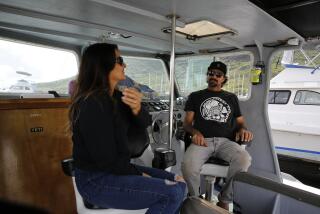Reservations No Longer Essential on Cook Islands
- Share via
RAROTONGA, Cook Islands — Until recently, Cook Island visitors had to have confirmed hotel reservations before they were allowed to enter the country.
Because there are only 649 hotel rooms, and camping is not allowed, it was a good way to control the number of visitors. Now you no longer have to have a reservation, but you must stay in a licensed establishment. Fortunately, several cater to travelers on student-style budgets.
The 15 Cook Islands are scattered over an area the size of Western Europe, between Tonga and Tahiti. Most young travelers decide to visit because they have been offered the option of a stop-over while traveling between Fiji or Tahiti and New Zealand.
You do not need a visa to visit, but you must have paid for passage out of the country and can stay only 31 days or less.
Two languages are spoken, a type of Maori (legend has it that the Maoris set off for New Zealand from the Cook Islands) and English.
The islands were first sighted by Europeans in 1595. Rarotonga, the only island with an international airport, was discovered by the Bounty mutineers in 1789.
In 1965, the Cook Islands became a self-governing nation, but they still maintain an association with New Zealand and use a combination of New Zealand currency and their own.
About half of the country’s 18,000 residents live on Rarotonga. Two roads circle its 20-mile circumference, linking small villages and limestone churches with citrus groves, plantations and the main town of Avarua.
White sandy beaches protected by coral reefs fringe the coast and rugged peaks jut up from the interior. The potholed roads are shaded by the lush tropical growth of hibiscus, frangipani and palm trees.
Although most of the islanders prefer Western-style clothing, it’s still quite common to see women, and sometimes men, wearing rings of fresh flowers around their heads.
Most international flights arrive in the early hours of the morning. Hotel staff members usually meet guests who have made reservations. If the transport isn’t free, it’s usually about $4 New Zealand (about $2.75 U.S.). A taxi would be much more expensive.
If you have a small group traveling together, your best bet would be to arrange for hotel rooms. Most hotels are quite small, often with 10 or fewer rooms, and usually include kitchens.
The Dive Hostel was created to provide cheap accommodations for divers, but it will accept any budget traveler. Accommodations are in single, twin and double rooms, and the rate is $13 New Zealand per person a night. There are shared cooking facilities. It’s walking distance from the beach.
Also highly recommended by young visitors is Tiare Village Motel. Budget lodging is provided in three A-frame houses at $13 per person a night.
Reservations can be made through airlines. More detailed information about hotels is available from Cook Islands Tourist Authority, P.O. Box 14, Avarua, Rarotonga, Cook Islands.
Buses circle the island hourly in each direction; the fare is $2 a ride. Scooters rent for $15 to $20 a day. You need a Cook Island driver’s license, available for $2 from the police station.
The best swimming is in the lagoon at Muri Beach. Windsurfing and snorkeling equipment is available there at the Rarotonga Sailing Club. A good snorkeling area is near the Little Polynesia Hotel.
A popular activity for young visitors on limited budgets is to take in the spectacular views from the cross-island hiking trail. Plan two to four hours to complete the trek and don’t go if it has been raining.
Although more competition is opening in town, Cook Island night life has for many years centered around a sagging green building next door to the tourist information office. The famous--or infamous--Banana Court Bar is open daily except Sunday, and offers live entertainment Wednesday through Saturday.
More to Read
Sign up for The Wild
We’ll help you find the best places to hike, bike and run, as well as the perfect silent spots for meditation and yoga.
You may occasionally receive promotional content from the Los Angeles Times.






